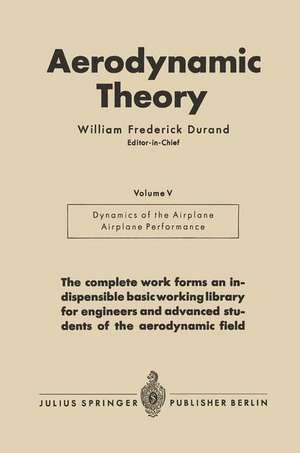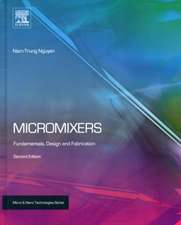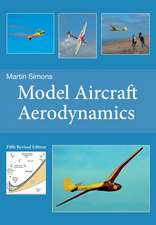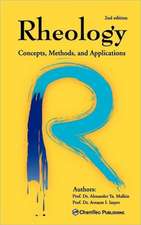Aerodynamic Theory: A General Review of Progress Under a Grant of the Guggenheim Fund for the Promotion of Aeronautics Volume V
Autor William Frederick Durandde Limba Germană Paperback – 31 dec 1934
| Toate formatele și edițiile | Preț | Express |
|---|---|---|
| Paperback (6) | 426.18 lei 6-8 săpt. | |
| Springer Berlin, Heidelberg – 31 dec 1934 | 426.18 lei 6-8 săpt. | |
| Springer Berlin, Heidelberg – 31 dec 1934 | 430.59 lei 6-8 săpt. | |
| Springer Berlin, Heidelberg – 1936 | 471.87 lei 6-8 săpt. | |
| Springer Berlin, Heidelberg – 31 dec 1934 | 502.73 lei 6-8 săpt. | |
| Springer Berlin, Heidelberg – 31 dec 1934 | 504.02 lei 6-8 săpt. | |
| Springer Berlin, Heidelberg – 31 dec 1933 | 505.30 lei 6-8 săpt. |
Preț: 502.73 lei
Preț vechi: 591.44 lei
-15% Nou
Puncte Express: 754
Preț estimativ în valută:
96.19€ • 100.44$ • 79.44£
96.19€ • 100.44$ • 79.44£
Carte tipărită la comandă
Livrare economică 15-29 aprilie
Preluare comenzi: 021 569.72.76
Specificații
ISBN-13: 9783642896316
ISBN-10: 3642896316
Pagini: 368
Ilustrații: XVIII, 347 S.
Dimensiuni: 155 x 235 x 19 mm
Greutate: 0.51 kg
Ediția:1935
Editura: Springer Berlin, Heidelberg
Colecția Springer
Locul publicării:Berlin, Heidelberg, Germany
ISBN-10: 3642896316
Pagini: 368
Ilustrații: XVIII, 347 S.
Dimensiuni: 155 x 235 x 19 mm
Greutate: 0.51 kg
Ediția:1935
Editura: Springer Berlin, Heidelberg
Colecția Springer
Locul publicării:Berlin, Heidelberg, Germany
Public țintă
ResearchDescriere
Dieser Buchtitel ist Teil des Digitalisierungsprojekts Springer Book Archives mit Publikationen, die seit den Anfängen des Verlags von 1842 erschienen sind. Der Verlag stellt mit diesem Archiv Quellen für die historische wie auch die disziplingeschichtliche Forschung zur Verfügung, die jeweils im historischen Kontext betrachtet werden müssen. Dieser Titel erschien in der Zeit vor 1945 und wird daher in seiner zeittypischen politisch-ideologischen Ausrichtung vom Verlag nicht beworben.
Cuprins
Division N Dynamics of the Airplane.- Preface.- I. Steady Motions and Limiting Accelerations.- 1. Introduction f. 5 — 2. Symmetric Flight p 5..- A. Steady Straight Symmetric Flight.- 3. Principal Forces Involved p. 6 — 4. Dimensionless Coefficients p 7 — 5. Horizontal Flight p.7 — 6. Indicated Air Speed p.9 — 7. Gliding Flight p. 10 — 8. Some Aspects of the Landing Problem p.11—9. Climbing Flight p. 12,.- B. Accelerated Symmetric Flight.- 10. Introduction p.13 — 11. Radius of Curvature of the Flight Path p.11 — 12. Minimum Radius of Curvature p.14—13. Minimum Radius of Curvature in Terms of Stalling Speed p. 15 — 14. Minimum Radius and Rapid Manoeuvres p.15 — 15. Apparent Gravity and Load Factors p 16 — 16. Measurement of Load Factors p.16 — 17. Maximum Load Factor p. 17..- C. Straight Asymmetric Flight.- 18. Steady Straight Side-slip p.18 — 19. Relation of Side-force to Side-slip p. 18 — 20. Relation of Side-slip to “Bank” p. 19..- D. Circling Fight.- 21. The Flat Turn p. 19 — 22. Side-slip in the Flat Turn p. 20 — 23. The True-banked Turn p. 20 — 24. Stalling Speed in a True- banked Turn p. 21 — 25. Power Required in a True-banked Turn p. 21 — 26. Horizontal Turn of Minimum Radius p. 21 — 27. Aero-dynamic Moments p. 22..- II. Symmetric or Pitching Moments.- 1. Pitching Moments and Static Stability p. 22 — 2. The Geo-metric Mean Chord p. 23 — 3. The Air-Reactions on an Isolated Wing p. 23 — 4. Functions of the Tail p.24 — 5. Fixed Tail and Elevators p. 25 — 6. Effect of C.G. Position on Static Stability p. 26 — 7. Dimensionless Coefficients p. 27 — 8. C.G. Positions for Neutral Equilibrium p. 27 — 9. A Relation Between Control and Stability p. 28 — 10. Experiments on Complete Models p. 29..- A. Contributions of Separate Parts of the Aeroplane to Pitching Moments.- 11. Introduction p. 29 — 12. Pitching Moments from Tail and Wings—C.G. on Wing Chord p. 30 — 13. Joukowski’s Theoretical Values for [dkM/dkL] p. 31 — 14. Pitching Moments When the C.G. is not on Wing Chord p. 32 — 15. Direct Contribution of the Airscrew to Pitching Moments p. 34 — 16. Numerical Values—Airscrew Contribution p. 35 — 17. Contribution of the Body and Minor Parts to Pitching Moments p. 36..- B. Forces on Tail and Interference Factors.- 18. Statement of Problem p. 36 — 19. Interference Between Aeroplane and Tail p. 37 — 20. Hinge Moments and Free Elevators p. 38 — 21. Wing-tail Interference p. 39 — 22. Airscrew-tail Interferences p. 40 — 23. Body-tail Interference p. 40 — 24. Airscrew- wing Interference p. 40 — 25. Interference Problems Discussed p. 41 — 26. Numerical Illustrations p. 41 — 27. Pitching Moments at Very High Speeds p 42 — 28. Pitching Moments in Stalled Flight p. 43..- C. Pitching Moments in Circling Flight (Mq).- 29. Introduction p. 44 — 30. The Tail in Circling Flight p 44 — 31. The Derivative Mqp. 45 — 32. The Dimensionless Coefficient (kmq) p. 45 — 33. Contribution of the Wings to M g p. 46 — 34. Direct Contribution of the Screw to Mqp. 46 — 35. Influence of Airscrew Slip-Stream on Tail p. 47 — 36. Numerical Illustration p. 47..- D. Experimental Methods of Measuring Mq.- 37. Whirling Arm Experiment p. 48 — 3S. The Free Oscillation Method p. 48 — 39. The Forced Oscillation Method p. 49 — 40. Relations between ?, Mq, and M ? p. 49—41. Experimental Separation of Mq and M à p. 51 — 42. Influence of the Screw on M ? p 52..- E. Experimental Results for Mq.- 43. Normal Flight p. 52 — 44. Mq in Stalled Flight p 53..- F. The Geometric Mean Chord.- 45. Statement of Problem p. 54 — 46. The Geometric Mean Chord Defined p. 54 — 47. Example of Application to a Biplane p. 56 — 48. Wings of Non-Rectangular Plan Form and with Dihedral Angle p. 56 — 49. Twisted and Tapered Wings p. 57..- III. The Asymmetric or Lateral Moments.- 1. Introduction p. 57—2. Axes p.57—3. Symbols p. 57—4. Dimensionless Coefficients p. 58—5. Controls p. 59—6. Independent Variables Which Govern Asymmetric Moments p. 59..- A. Effects of Side-Slip.- 7. Dihedral Angle p. 59—8. Theoretical Estimates of Rolling Moments Due to Side-Slip p. 60—9. Theoretical Estimate of Yawing Moment Due to Side-Slip p. 61—10. Conversion to Chord Axes p. 61—11. Omissions in the Assumptions p. 61— 12. Experimental Measurements of the Effects of Side-Slip on an Isolated Wing p. 62—13. klv in Stalled Flight p. 62—14. Effect of Side-Slip on Body, Fin and Rudder p. 63—15. Experimental Values of klv and knv for Complete Model Aeroplanes p. 65—16. Effects of Large Side-Slips p. 67..- B. Theoretial Estimates of Moments due to Angular Velocities of Roll and Yaw.- 17. Moments Due to Rate of Yaw p 67—18. The Derivatives klr and knrp69—19. Moments Due to Rate of Roll (p) p. 70—20. Approximate Formulae for the Rotary Derivatives p 71 —21. Change of Axes p. 71 —22. Calculations of Rotary Derivatives Using Chord Axes Throughout p 72 —23. Rotary Derivatives Due to Body, Fin and Rudder p 73..- C. Experimental Methods of Measuring the Rotary Derivatives.- 24. Oscillation Methods p. 73 — 25. Continuous Rotation Methods p 73..- D. Discussion of the Results of Experiments on the Rotary Derivatives at Incidences of Normal Flight.- 26. Comparison Between Oscillation and Continuous Rotation Experiments p. 74 — 27. Comparison Between Experiment and “Strip” Calculation p. 74 — 28. Influence of Body, Fin and Rudder p. 75 — 29. Comparison Between Model and Full Scale Experiments p. 75 — 30. Effect of Large Angular Velocities p. 75 — 31. Summary- Rotary Derivatives in Normal Flight p 75..- E. Rotary Derivatives in Stalled Flight.- 32. Introduction p. 76 — 33. Theoretical Estimate of Moments Due to Finite Rates of Roll p 76 — 34. Comparison Between Strip Hypothesis and of Experiments with Continuous Finite Rates of Roll p. 78 — 35. Comparison Between Strip Hypothesis and Experiments with Continuous Yawing p. 79 — 36. Comparison Between Continuous Rotation and Oscillation Experiments p. 80 — 37. Auto- Rotation and Wing Tip Slots p. 81 — 38. Collection of Typical Values for the Six Asymmetric Moment Derivatives p. 81..- F. The Asymmetric Controls.- 39. Balanced Controls p. 82 — 40. Aileron Rolling Moments p. 83 — 41. Aileron Yawing Moments p 83 — 42. Ailerons and Wing Tip Slots p. 84 — 43. The Rudder in Normal Fight p. 84 — 44. The Rudder in Stalled Flight p. 85..- IV. Free Flight-Simple Discussion.- 1. Introduction p. 85 — 2. Lanchester’s Idealized Flight Path p. 86 — 3. Equation of the Fight Path p. 87 — 4. Forms of the Flight Path p. 88 — 5. Comparison with the Path of a Real Aeroplane p. 89..- A. The Slow Oscillation of Small Amplitude.- 6. The Ideally Simple Oscillation p. 90 — 7. Form of the Oscillation of Small Amplitude p. 90— 8. Comparison with the Oscillation of a Real Aeroplane p. 91 — 9. The Effect of Mq on the Period p. 91 — 10. The Damping of the Oscillation p. 94 — 11. Influence of the Airscrew p. 95 — 12. Other Factors which Influence the Oscillation p. 95 — 13. Gliding and Climbing Flight p 95 — 14. The Unstable Aeroplane p. 95..- B. The Rapid Incidence Adjustement.- 15. Simplifying Assumptions p. 96 — 16. Sudden Change of Incidence p. 96 — 17. Sudden Application of Elerators p. 98 — 18. Solutions with More Complete Assumptions p. 99 — 19. Discussion of the Solutions p. 101— 20. Unstable Aeroplanes p. 102 — 21. Stable Aeroplanes p. 103 — 22. Dimensionless Forms of the Quadratic for ?p. 103..- C. Asymmetric Motions.- 23. Statement of the Problem p. 104— 24. The True-banked Steady Turn p. 105 — 25. The Steady Turn with Side-Slip p 107 —26. Ascending and Descending Steady Turns p 108..- D. Small Disturbances from Straight Flight.- 27. Introduction p. 109 — 28. The Rapid Damping of Rolling Motions p. 110 — 29. The Slow Spiral Motion p. 111 — 30. More Accurate Estimate of the Spiral Motion p. 113 — 31. The Oscillation of a Statically Stable Aeroplane p. 113 — 32. The Oscillation of a Statically Neutral Aeroplane p. 116 — 33. The Oscillation of a Statically Unstable Aeroplane p. 117 — 34. The Two Possible Forms of Instability p 117..- E. The Stalled Aeroplane.- 35. The Stalled Aeroplane-Symmetric Motion p. 118 —36. The Stalled Aeroplane-Asymmetric Motion p. 119..- V. The Equations of Motion with Solutions for small Disturbances from Steady Symmetric Flight.- A. Axes, Symbols and Equations of Motion.- 1. Axes p. 121 — 2. Orientation p. 122 — 3. Symbols p. 122 — 4. Effect of Gravity p. 123 — 5. The Equations of Motion p. 123 — 6. Dependence of the Air-Reactions on the Velocity Components p. 124 — 7. Influence of W on M p. 125 — 8. Step-by-Step Methods of Solution p. 125 — 9. Steady Motions p 126..- B. Small Disturbances from Steady Symmetric Flight.- 10. Historical p. 126 — 11. Moderate Finite Disturbances p. 127 — 12. Force and Moment Derivatives p. 127 — 13. Shortened Notation p. 128 — 14. The Applied Forces p. 128 — 15. The Mass Accelerations p. 129 — 16. Separation into Symmetric and Asymmetric Groups p. 129 — 17. The Equations of Motion Rearranged p. 130..- C. Conversion to Dimensionless Form.- 18. Introduction p. 130 — 19. The Parameter p. 131 — 20. The Dimensionless System Explained p. 132 — 21. The Equations of Motion in Dimensionless Form p 134..- D. The Solutions of the Equations of Motion.- 22. Introductory p. 135 — 23. The Complementary Function p. 135—24. The Quartic Equation for A p 136 — 25. The Ratios u1:w1:q1p. 136 — 26. The Four Arbitrary Constants p. 137 —27. General Form of the Complementary Function p. 137 — 28. Initial Conditions p. 137 — 29. Solutions of the Asymmetric Group p. 138 — 30. Complex Roots p 138 — 31. Complex Roots in the Asymmetric Equations p. 141..- E. Complete Solution with Constant Applied Control Couples.- 32. No Roots Zero—Symmetric Group p. 141 — 33. No Roots Zero—The Asymmetric Group 14:2 — 34. One Root Zero—The Symmetric Group p. 142 — 35. One Root Zero—The Asymmetric Group p. 143 — 36. Two Roots Zero p. 144 — 37. Case of Equal Roots p. 144..- VI. Numerical Solution of the Symmetric Equations of Chapter V.- 1. Introduction p. 144 — 2. Notation and Axes p. 144 — 3. Evaluation of the Derivatives p. 145 — 4. The Force-Velocity Derivatives p. 146 — 5. Force-Rotary Derivatives p. 147 — 6. Moment-Velocity Derivatives p. 148 — 7. Moment-Rotary Derivatives p. 148 — 8. The Derivative mwp. 148 — 9. Choice of Numerical Examples p. 149 — 10. The Derivatives p 149 — 11. The Examples Specified p. 150 — 12. The Constants Tabulated p. 151..- A. The Complementary Function.- 13. The Equations of Motion p. 152 — 14. The Quartic for ? p 152 — 15. Information from Inspection of the Quartic for ? p. 152 — 16. Values of ? and of the Ratio u1:w1:q1p. 154..- B. Complete Solutions and Initial Conditions.- 17. Choice of Initial Conditions p. 157 —18. Complete Solutions in Dimensionless Form p. 160 — 19. Conditions to which the Solutions Apply p. 160 — 20. The Solutions Discussed p. 161 — 21. Conversion to Ordinary Units p. 162 — 22. The Solutions In Terms of Other Variables p 163 —23. Graphs of the Solutions Plotted Against Time p. 163..- C. The Graphs Discussed.- 24. Introductory p. 164 — 25. Cruising Speed—Elevator Movement p. 164 — 26. Cruising Speed—Vertical Gust p. 165 — 27. Cruising Speed—Horizontal Gust p. 165 — 28. Slow Speed—Unstalled p. 165 — 29. Stalled Flight p. 168..- D. Approximations Applicable to Normal Flight Only.- 30. Statement of the Problem p. 168 — 31. The Quartic of ? p. 169 — 32. Equations of Motion Referred to Wind Axes p. 170 — 33. Gliding Flight—Engine Off p 171 — 34. Numerical Values p. 172 — 35. The Large Quadratic Root p. 172 — 36. The Small Quadratic Root p. 173..- E. Level Flight.- 37. Introductory p. 174 — 38. Effect of Airscrew on mwp. 175 — 39. Effect of Airscrew on mq and mwp. 175 — 40. The Effect of the Airscrew on xw, zu, zwp. 176 — 41. The Value of dT/dV for an Airscrew p. 176 —42. The Effect of Airscrew on xup. 177 — 43. Effect of Airscrew on mu p. 178 — 44. Effect of Airscrew on the Coefficients B, C and E in the Quartic for ? p. 179 — 45. Effect of Airscrew on the Damping of the Slow Motion p. 180 — 46. Numerical Values p. 180 — 47. The Effect of Freeing the Elevators p. 181..- VII. Numerical Solutions of the Asymmetric Equations.- I. Introduction p. 182 — 2. Notation and Axes p. 182 — 3. Choice of Illustrative Examples p. 183 — 4. Cruising Speed p. 183 — 5. Slow Speed p. 184 — 6. Stalled Flight p 184 — 7. Table of Dimensionless Constants p. 185..- A. Complementary Function.- 8. The Equations of Motion p 185 — 9. The Quartic for ? p 185 — 10. Values of ? and of the Ratios v: p: rp. 185 — 11. The Large Real Root p 187 — 12. The Small Real Root p. 187 — 13. The Complex Root p. 187..- B. Complete Solutions and Initial Conditions.- 14. Choice of Initial Conditions p. 188 — 15. Complete Solutions in Dimensionless Form p. 188 — 16. Conditions to which the Solutions are Applicable p. 188 — 17. Conversion to Ordinary Units p 189 — 18. Graphs of the Solutions Plotted Against Time p. 191..- C. The Graphs Discussed.- 19. Initial Rate of Roll p. 192 — 20. Applied Control Moments p. 193 — 21. Applied Rolling Moment p. 193 — 22. Applied Yawing Moments p. 196 — 23. Rolling and Yawing Moments Applied Simultaneously p. 196 — 24. Stalled Flight p. 197 — 25. Uncertainty of the Values of the Derivatives in Stalled Flight p 198 26. Scale Effect on a Thick Wing in Stalled Flight p 199..- D. Information by Inspection of the Quartic for ?.- 27. Condition for Complete Stability p 199 — 28. The Large Root p. 199 — 29. The Small Root p. 200 — 30. Approximate Values of the Complex Roots p. 200 — 31. Level and Climbing Flight p 201..- E. Changes of Dihedral Angle and Fin Area.- 32. Introduction p. 202 — 33. Spiral Instability p. 202 — 34. Increasing Oscillations p. 202 — 35. Spinning Instability p. 203 — 36. Summary p. 203..- VIII. The Spin.- 1. Introduction p. 204 — 2. Experimental Methods p. 205 — 3. Theoretical Calculations p. 206 — 4. Notation and the Equations of Motion p. 207..- A. Autorotation.- 5. Rotation about a Fixed Axis p. 208 — 6. Autorotation Defined p. 209 — 7. Latent Autorotation p 209 8. Autorotation Rates p. 210..- B. Pitching Moments.- 9. The Centrifugal Pitching Moment p. 210—10. The Origin of the Centrifugal Pitching Moment p 211 — 11. Balance of Pitching Moments p. 213..- C. The Remaining Degrees of Freedom.- 12. Freedom to Slide along the Axis of Rotation p. 214 — 13. Freedom to Leave the Axis of Rotation p 214 — 14. Two Final Degrees of Freedom p. 215..- D. Effects of Yaw on the Spin.- 15. The Meaning of Yaw p. 215 — 16. The Relation between Yaw and Side-Slip p. 216 — 17. The Effects of Yaw on Rate of Spin p. 216 — 18. The Air Yawing Moment p. 217 — 19. The Centrifugal Yawing Moment p. 218..- E. The Free Spin of Real Aeroplanes.- 20. Rotation Rate and Incidence p. 219 — 21. Radius and Rate of Descent p. 219 — 22. Load Factor and Incidence p. 220 — 23. Critical Nature of Transition to Flat Spin p. 220 — 24. Reasons for Failure of Ailerons and Rudder p. 221..- References.- Division O Airplane Performance.- Editor’s Preface.- I. Fundamental Relations.- 1. Introduction p. 224 — 2. Aerodynamics p. 225 — 3. Engine Power p. 226 — 4. Standard Atmosphere p. 226..- II. Basic Computations.- A. Power Required.- 1. Data Necessary p. 227 — 2. Lift, Lift Coefficient and Speed p. 227 — 3. Induced Drag and Equivalent Monoplane Aspect Ratio p 230 — 4. Profile Drag of Airfoils and Its Variation p. 232 —5. Structural Drag and Its Variation p. 233 — 6. Total Drag and Power Required at Sea Level and at Altitude p. 239..- B. Power Available.- 7. Power Curves of Engines p. 243 — 8. Choice of Propeller Diameter p. 244 — 9. Design v/n and Maximum Efficiency p. 245 — 10. Variation of Engine Speed and Power at Sea Level (Full Throttle) p. 246 — 11. Variation in Propeller Efficiency p. 247 — 12. Power Available at Sea Level and at Altitude (First Method) p. 257 — 13. Power Available at Sea Level and Altitude (Second Method) p. 248..- III. Performance from Power Graphs.- 1. High Speed p. 250 — 2. Rate of Climb p. 252 — 3. Ceilings p. 255 — 4. Angle of Ceilings p. 255 — 5. Time of Climb p. 256 6. Power Required p. 256 (A. Power Required by Summarizing Component Drags p. 257 — B. Power Required by Estimating A Directly p. 258) — 7. Power Available p. 261 (A. Power Available from Variation of R.P.M. with Speed p. 261 — B. Power Available from ratio of Thrust Power p. 263) — 8. Performance p. 264..- IV. Bairstow’s Method.- 1. General Outline of Method p. 267 — 2. Speed of Climb p. 269..- V. Lesley-Beid Method.- 1. Introduction p. 270 — 2. Data Required p. 270 — 3. Description of Method. Level Flight p. 271 — 4. Example of Performance Calculations p. 274..- VI. The Oswald Method.- 1. Parameters p. 280 — 2. Assumptions p. 281 — 3. Theory p. 282 — 4. Charts p. 285..- VII. Empirical-Theoretical Method.- VIII. Logarithmic Diagrams.- 1. Introduction p. 296 — 2. Theory p. 297 — 3. Determination of Performance p. 303..- IX. Range and Endurance.- 1. Range p. 305 — 2. Endurance p 311 — 3. Breguet’s Formulas p 312..- X. Influence of Principle Factors on Performance.- 1. Weight p. 315 — 2. Power p. 316 — 3. Wing Area p. 317 — 4. Span of Equivalent Monoplane p. 318 — 5. Airfoil Characteristics p. 318 — 6. Parasite Resistance p. 319 — 7. Propeller Characteristics p. 319 — 8. Supercharging and Throttling p. 320 — 9. Choice of Altitude Propeller p. 320 — 10. Power Absorbed by Any Propeller p. 321 — 11. Power Available at Sea Level from Special Propeller p. 323 — 12. Example p. 323..- XI. Limits of Performance.- 1. Speed Range p. 324— 2. High Speed p 328 — 3. Initial Rate of Climb p. 329 — 4. Absolute Ceiling p. 330 — 5. Range p. 332 — 6. Endurance p. 333..- Appendix I. The Induced Drag of any Biplane 333 Equivalent Monoplane Span for any Biplane p. 333..- Appendix II. Biplane Wing Lift Coefficients.- References.













